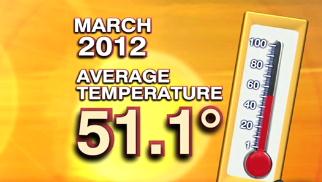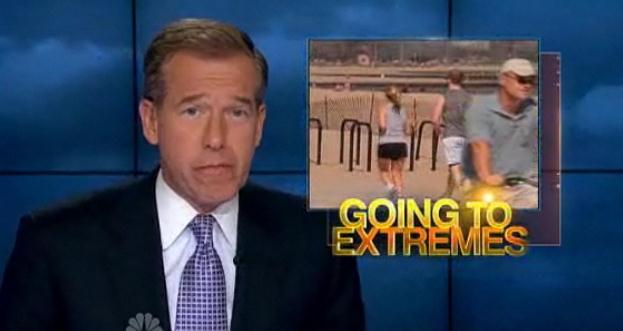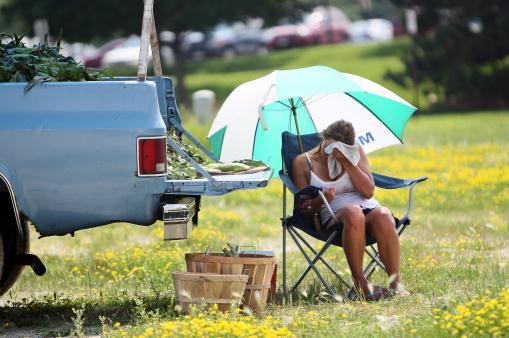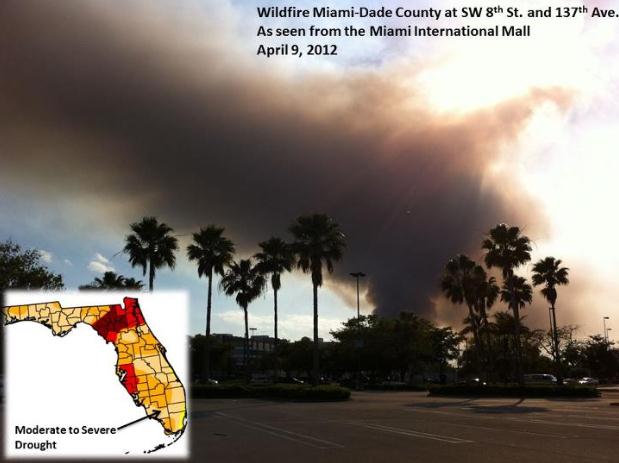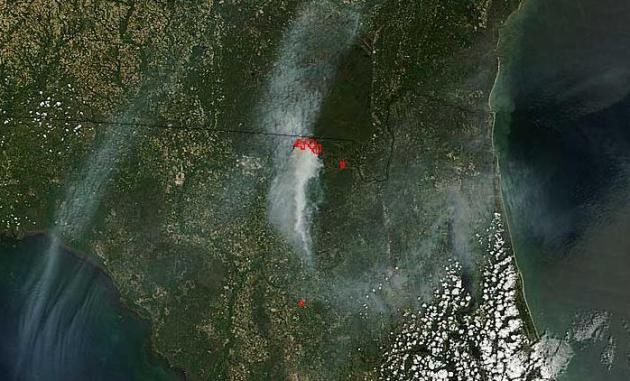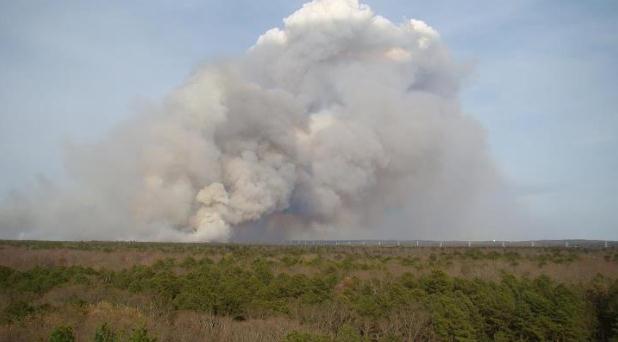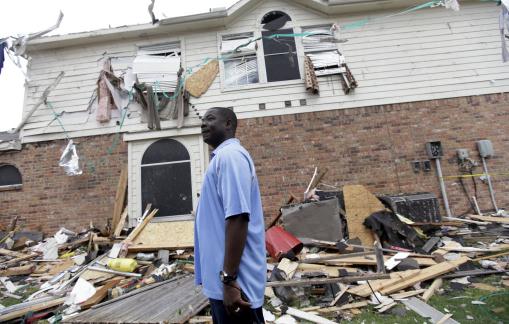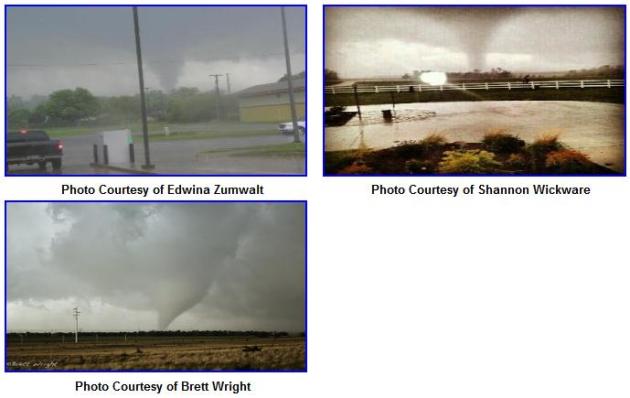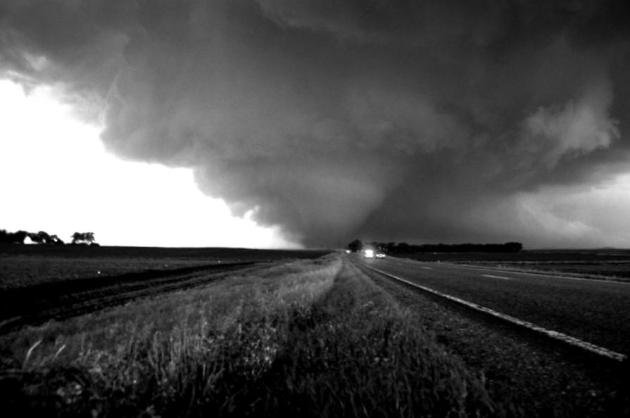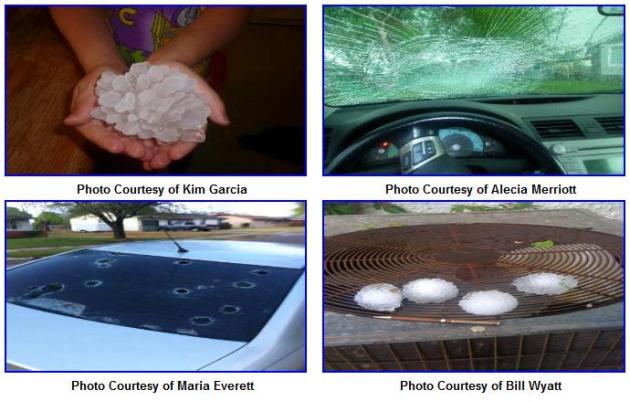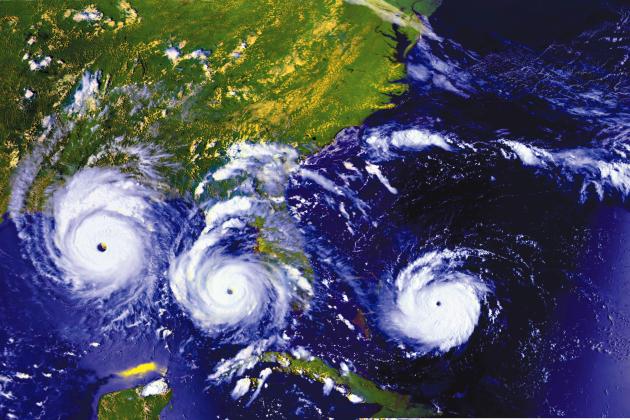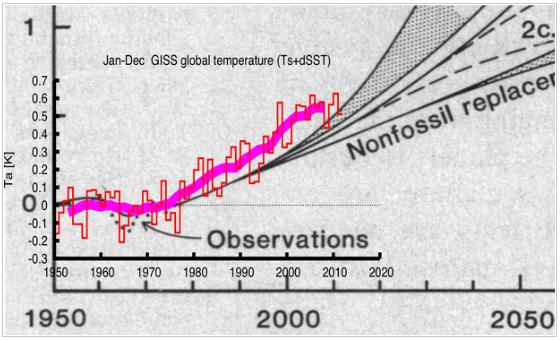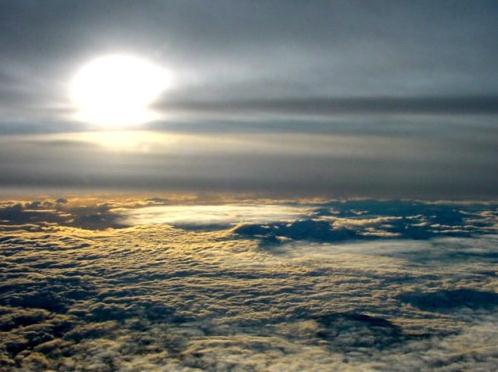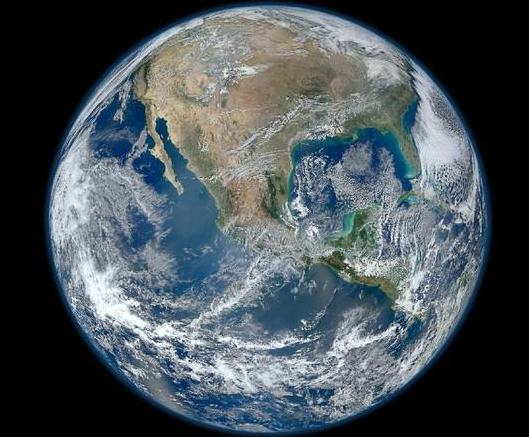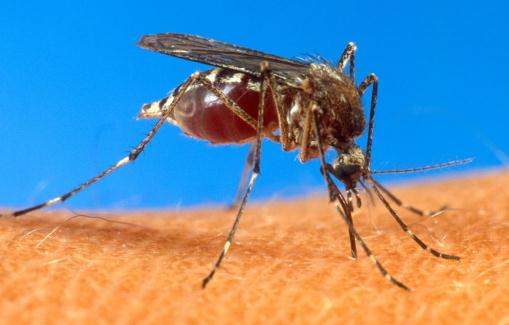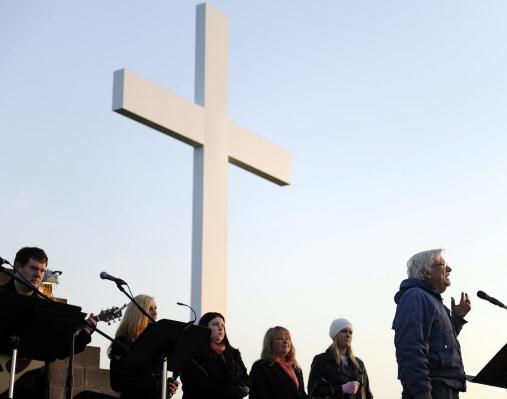25 states east of the Rockies experienced their warmest March on record.
15 additional states:
March was in the Top 10 Warmest List.
"
It blew the doors off any existing records," Carbin said. "I think everybody is quite shocked at how warm a month March was across the continental U.S." - from a Yahoo News story; details below.
"
Every state in the nation experienced at least one record warm daily temperature during March. According to preliminary data, there were 15,272 warm temperature records broken (7,755 daytime records, 7,517 nighttime records). Hundreds of locations across the country broke their all-time March records. There were 21 instances of the nighttime temperatures being as warm, or warmer, than the existing record daytime temperature for a given date." - Twin Cities NWS office, details below.
82 million metric tons of carbon dioxide was pumped into the atmosphere in 2010, worldwide - a new record.
"
The researchers estimated that greater summer temperature variability, a predicted consequence of climate change, is causing 10,000 additional deaths per year in the United States, a figure that is likely to rise along with the mercury." - from a story at boston.com; details below.
"The researchers found that long-term warming resulted in loss of native species and encroachment of species typical of warmer environments, pushing the plant community toward less productive species. - from a story at cattlenetwork.com.
 U.S. Records Warmest March; More Than 15,000 Records
U.S. Records Warmest March; More Than 15,000 Records. Here's an
amazing post from the local Twin Cities NWS: "
Record and near-record breaking temperatures dominated the eastern two-thirds of the nation and contributed to the warmest March on record for the contiguous United States, a record that dates back to 1895. More than 15,000 warm temperature records were broken during the month. The average temperature of 51.1 F. was 8.6 degrees above the 20th century average for March and .5 F. warmer than the previous warmest March in 1910. Of the more than 1,400 months (117+ years) that have passed since the U.S. climate record began, only one month, January 2006 has seen a larger departure from its average temperature than March 2012."
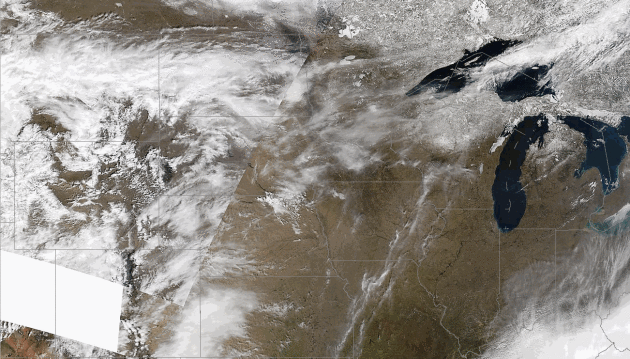 Second Week of April: 2008 to 2012.
Second Week of April: 2008 to 2012. Quite a difference from one year to the next. Animation courtesy of the MSP
National Weather Service and NASA's
MODIS satellite.
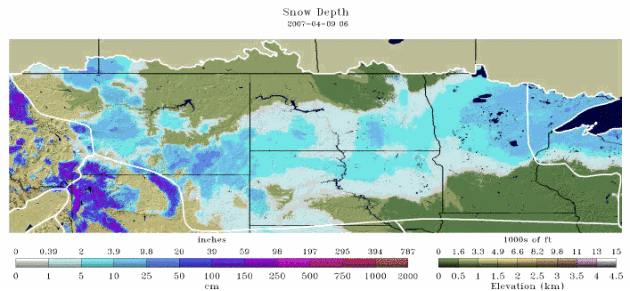 April 9: 2007 - 2012
April 9: 2007 - 2012. No, spring flooding won't be a problem this year. Map courtesy of
NOAA.
 Small-Grain Planting
Small-Grain Planting. Check out this post from the Twin Cities NWS: "
Small grain planting continued at a strong pace aided by warm, dry conditions, according to the USDA, NASS, Minnesota Field Office. For the week ending April 8, spring wheat advanced 22 percentage points to 25 percent planted, compared to 0 percent last year and 1 percent for the five-year average." - Excerpt from Minnesota Ag News/Crop Weather (USDA)
Diane Sawyer At ABC News: "Spring Temperatures Break Record". Check out the
Monday evening segment from ABC News. Connecting the dots.
not to be forgotten....dueling weather/climate pieces at network level:
Brian Williams On NBC News: "Going To Extremes". Check out the
video segment on NBC News Monday evening - making the link between extreme warmth being yet another possible symptom of climate change.
 Two Opportunities For Rain
Two Opportunities For Rain. I'm not terribly impressed with the potential for significant rain, maybe a quarter inch late Thursday night into Friday, another .2 to .4" rain late Monday and Tuesday as colder air arrives. We need about 3-7" just to get back up to "normal". That won't happen anytime soon.
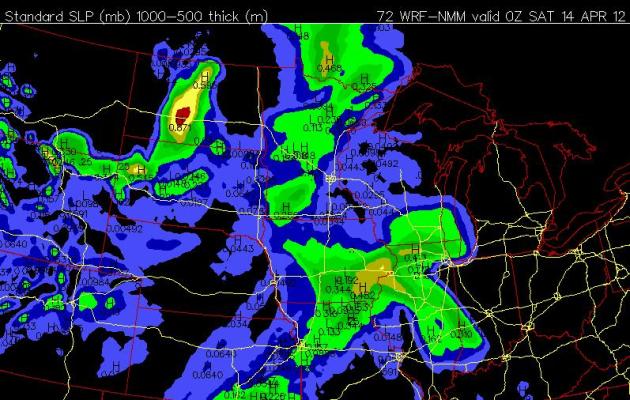 Plan B For Friday Activities.
Plan B For Friday Activities. I still don't think we'll see a steady, all-day rain on Friday, no wash-outs, but a few showers and T-storms are possible late Thursday into Friday, a stray shower or T-storm may spill over into Saturday. Sunday still appears to be the drier day of the weekend.
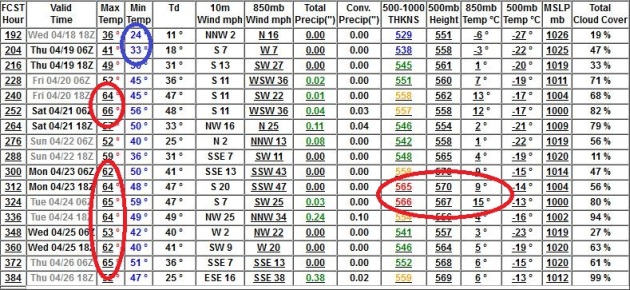 One More Frost? Then More 60s
One More Frost? Then More 60s. Tuesday I was hassled, in a good-natured way, in downtown Minneapolis. "Where are the 70s Paul!" Man, are we spoiled. The GFS
hints at a touch of frost the middle of next week - can't rule out another freeze, especially outlying suburbs, then a run of 60s, maybe some 70s by April 23-24. Yes, this is payback for the warmest March on record.
Big Shifts In Summer Heat Tied To Death Risk. Details from
boston.com: "
Large daily temperature swings during the summer may shorten life expectancy for elderly people with chronic medical conditions, potentially causing thousands of deaths each year, a study by researchers at the Harvard School of Public Health has found. While extended heat waves are known to be dangerous for senior citizens, new research found that big changes in average temperatures from one day to the next can be harmful, too. For each increase of 1 degree Celsius in summer temperature variability, the death rate for infirm elderly residents rose between 2.8 percent and 4 percent, depending on the ailment, the study found."
Photo credit above: "In this July 18, 2011 file photo, Tiffany Carrels, of Lake City, Minn. wipes the sweat from her face with a towel as she sells sweet corn at the side of the road in Northfield, Minn. during the sweltering heat. Workers and residents are contending with highest temperatures of the summer season as a prolonged stretch of hot, humid weather takes hold on the upper midwest region of the United States. (AP Photo/The Star Tribune, Renee Jones Schneider, File)."
Fires Contained But Not Over: Suffolk County (New York) Declared State Of Emergency. Many northern tier states are faced with a high fire risk. Long Island, New York has been hit pretty hard;
Hamptons.com has more details: "
Southampton - More than 35 fire departments from both Suffolk and Nassau counties are still on the scene continuing to monitor the spread of any pop up fires that continue to threaten the area. At one time all 109 departments were on the scene. For more than 24 hours, fire fighters have battled a blaze that began Monday, April 9, 2012, north of Brookhaven Lab and raged through the Pine Barrens area of Ridge and Manorville, consuming approximately 1,000 acres. With nine structures destroyed, the volunteer fire fighters with air National Guard and state police water drops have finally contained the fires. Consisting of more than 100,000 acres, fires in 1995 consumed more than 9,000 acres of the Pine Barrens. The fire began around 3 p.m. Monday, fueled by high winds and lack of ground moisture."
Photo credit above: "
The air was thick with black smoke on the East End. (Courtesy Photo: Local Fire Department Personnel)."
A long portion of Interstate 64 has been closed west of Lexington, VA - due to rapidly moving forest fires:
http://www.virginiadot.org/newsroom/staunton/2012/portion_of_interstate_6457274.asp
http://www.wdbj7.com/news/wdbj7-fire-crews-working-several-forest-fires-in-alleghany-county-20120408,0,7751108.story
http://www.wdbj7.com/news/wdbj7-the-blue-team-comes-in-to-help-manage-area-fires-20120410,0,3340993.story
* thanks to James Aman from Earth Networks for passing this along to me.
Florida Wildfire Threat. Details from the
Miami office of the National Weather Service: "
Wildfires this time of the year are common across Florida, and yesterday was no exception. The weather pattern continues to look dry for South FL over the next couple of weeks. Until we begin to see the daily thunderstorms develop with the rainy season (median onset date is May 20th), we’ll likely be contending with this dry pattern and the corresponding wildfire danger." Oh, and thank you Mark Zuckerburg for ditching class at Harvard to invent Facebook and make it so 'dang easy to share social media. Well done.
Florida Wildfire Spied From Space. It's a little unnerving tracking so many fires, so early in the season. If this were August the current rash of wildfires and brushfires would be fairly typical, as foliage often dries out in late summer. But April? Here's more from
Our Amazing Planet: "
A satellite snapped an image this week of a massive plume of smoke hovering over a Florida forest. The smoke is coming from a large wildfire that has raged in the region since it was sparked by a lightning strike in the early hours of April 5. Known as the County Line Wildfire, it has burned approximately 18 square miles (47 square kilometers) of the Osceola National Forest in the far northern part of the Sunshine State." Photo courtesy of NASA.
Watch Your Butts. Cigarette buts...barbecues...burning trash...random sparks from highway traffic. Why do I think it's going to be a long, hot (fiery) summer. Details from the New York City office of the NWS via
Facebook: "
Photo of the brush fire in Ridge/Manorville that was taken Monday afternoon from the KOKX radar site."
 Combating Tornado Fatigue: A Proposal For "Tornado Alerts" and "Tornado Emergencies". I wrote this article for Huffington Post on Tuesday because of a growing sense of apathy about generic tornado warnings. With Doppler we're seeing tornadic circulations we never saw before; the number of small EF-0 and EF-1 tornadoes has spiked, and so have subsequent tornado warnings. In fact every time there's a strongly rotating storm the NWS usually issues a tornado warning, just in case. I get it - nobody wants to hear "there was no warning!" But as a result many people don't take the tornado warnings seriously - they hear the sirens, turn on the TV, look at their phones or iPads, waiting to see if "the threat is real". I wrote an article for the Huffington Post with a humble suggestion: 2 different flavors of tornado warnings: a "Tornado Alert" for rotation-based storms that are ripe to drop a tornado, and "Tornado Emergencies" for CONFIRMED tornadoes on the ground. Here's an excerpt:
Combating Tornado Fatigue: A Proposal For "Tornado Alerts" and "Tornado Emergencies". I wrote this article for Huffington Post on Tuesday because of a growing sense of apathy about generic tornado warnings. With Doppler we're seeing tornadic circulations we never saw before; the number of small EF-0 and EF-1 tornadoes has spiked, and so have subsequent tornado warnings. In fact every time there's a strongly rotating storm the NWS usually issues a tornado warning, just in case. I get it - nobody wants to hear "there was no warning!" But as a result many people don't take the tornado warnings seriously - they hear the sirens, turn on the TV, look at their phones or iPads, waiting to see if "the threat is real". I wrote an article for the Huffington Post with a humble suggestion: 2 different flavors of tornado warnings: a "Tornado Alert" for rotation-based storms that are ripe to drop a tornado, and "Tornado Emergencies" for CONFIRMED tornadoes on the ground. Here's an excerpt: "
....
Be honest. The last time a tornado warning was issued for your neighborhood did you immediately make a run for the basement (or bathtub)? Or did you flip around the TV dial, maybe call up radar on your laptop or an app on your iPad? Did you wander to the window, or check the film in your camera and consider running outside to get that award-winning photo that would catapult you to instant fame (if not fortune?) It's a real problem. We've become a nation of second-guessing arm-chair meteorologists. Recent studies confirm that most of us don't do the right thing until we have multiple confirmations, from different sources, that the threat is real, and relevant. Meanwhile, an EF-4 is churning toward your house at 40 mph, and you're sitting there wondering why you have a weak WIFI signal. It's an accident waiting to happen, and I'm as guilty as the next guy.
Another challenge: unlike hurricanes, which are rated on a scale of 1 to 5, meteorologists still don't have the tools to be able to estimate, in real-time, how severe a developing tornado might be. Running hyper-local weather models from coast to coast might help, but the plain truth: we simply don't know if a spinning storm on Doppler will go on to spin up a minor EF-0, capable of minor roof damage and broken tree limbs, or an awe-inspiring EF-5, capable of steam-rolling homes into oblivion, turning towns into instant war-zones. We may get there in our lifetime, but this is a huge meteorological problem."
* photo above taken by WeatherNation TV meteorologist Aaron Shaffer during the June 17, 2010 Albert Lea tornado.
Deadly March Tornadoes Are 2012's First Billion Dollar Disaster. Yahoo News has more facts: "
A swarm of tornadoes that tore through the Midwest and Southeast in early March has earned the grim title of the nation's first billion-dollar weather disaster of 2012. From March 2 through the early hours of March 3, 132 tornadoes were reported across nine states. Although those numbers are preliminary, and will undoubtedly decrease once overlapping reports are eliminated, their aftermath was devastating, causing more than $1.5 billion in damage and killing 40 people. The storms killed four people in Ohio, but they took the greatest toll in Indiana, killing 13, and Kentucky, where 23 people died."
Photo credit above: "
Charles Paige stands amongst tornado debris as he surveys the damage to his home Wednesday, April 4, 2012, in Forney, Texas. The mayor of Forney, Texas, says it's "a real blessing" that nobody was killed in the community by the tornadoes that ripped through parts of the Dallas area yesterday (AP Photo/Tony Gutierrez)."
Alaska's Largest City Sets Snowfall Record. Here's a terrific
YouTube clip highlighting a record snow year for Anchorage, courtesy of AP: "
A spring snowfall has broken the nearly 60-year-old seasonal snow record of Anchorage, Alaska, the state's largest city. Residents have seen more than 133 inches fall this season, surpassing the record of 132.6 inches set in 1954-55. (April 9)."
April 9 Woodward, Oklahoma Tornado. Thanks to the photographers highlighted above, and the Norman, Oklahoma office of the NWS for sharing
these. .
Rough Terrain Can Channel A Tornado's Damaging Winds, New Research Suggests. An intriguing story from
Science Daily - here's an excerpt: "
ScienceDaily (Apr. 9, 2012) — Christopher Karstens was on the ground studying the damage caused by the deadly April 27, 2011, tornado that hit Tuscaloosa and Birmingham, Ala. It was just a week after the tornado. He was between the two cities, in the rough country of the southern Appalachians about 20 miles northeast of Tuscaloosa. He said it's terrain that's "beyond hilly." It's covered by dense forest and clogged by high brush that's tough to walk through. A hike of about 100 yards sometimes took as long as 45 minutes. It was a perfect place for Karstens -- a doctoral student from Atlantic who's studying under the direction of Bill Gallus, a professor of geological and atmospheric sciences -- to study the effects of complex terrain on the structure of a tornado."
Photo credit above: "
Iowa State University's Tornado/Microburst Simulator runs over a 3-D model of a 2-mile by 3-mile section of rough Alabama countryside. (Credit: Photo courtesy of Christopher Karstens/Iowa State University)."
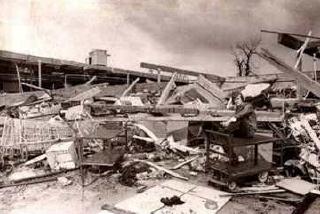 40th Anniversary Of Great Vancouver Tornado
40th Anniversary Of Great Vancouver Tornado. Meteorologist Steve Pierce has a very interesting read at
The Columbian; here's an excerpt: "
The Vancouver tornado of 1972 stands alone in the record books. It is the holy grail of Pacific Northwest tornadoes. Even now, 40 years later, the April 5th 1972 Vancouver tornado is the single deadliest tornado to strike west of the Rocky Mountains in modern history, killing six people and injuring more than 300 in Vancouver, Washington alone. Those who lived through that day witnessed the fury of mother nature to a degree that is not likely to be matched again anytime soon. The 1972 tornado was similar in atmospheric structure to that of the Hazel Dell tornado of January 2008. However, the 1972 tornado was much stronger. The 2008 Hazel Dell tornado was an EF1 on the newer Enhanced Fujita scale that became operational in 2007. Winds were likely between 90-110 MPH in the 2008 Hazel Dell tornado. The Vancouver tornado of 1972 was rated an F3 under the original Fujita scale which came online in 1971. Winds on the older Fujita scale were estimated between 158–206 MPH if rated as an F3, as was the case in the Vancouver tornado of 1972." Photo credit above from
seattle-tourist.com.
* Wikipedia has a good summary of this tornado, the deadliest since 1871 for the west coast,
here.
Are You Prepared For A Tornado? Some interesting facts on sirens and tornado preparedness from
tmc.net: "
...Some areas don't have sirens and sometimes sirens malfunction. Area sirens are typically electric with battery or solar power back-up, but other errors could occur, such as a transmission failure. Cities with sirens have different criteria for sounding them. Most cities sound the sirens when the National Weather Service issues a tornado warning for their area. That means a tornado was sighted by a trained spotter or weather conditions are ripe for a tornado. But some cities also do so for other emergencies, such as damaging winds or fire calls."
Photo credit above: June 17, 2010 Albert Lea tornado, courtesy of WeatherNation TV meteorologist Aaron Shaffer.
** USA
Today has an excellent article on the "new, wider" tornado alley, the apparent eastward shift in where the most violent tornadoes are touching down
here.
Serious "Hailers". Good grief - when you're driving around in Oklahoma during prime time for severe storms (um...right about now) it's best to borrow a friend's car. Someone you don't really like very much. The
Norman, Oklahoma office of the National Weather Service shared these remarkable photos of the hailstorm that bombarded Woodward on April 9. The bigger the hail, the stronger the T-storm updraft, the higher the probability of enough upward motion for a tornado.
Are Category 6 Hurricanes Coming Soon? Here's an August, 2011 article at
Scientific American I somehow missed - but wanted to include in today's blog: "
Atmospheric researchers tend to agree that tropical cyclones of unusual ferocity are coming this century, but the strange fact is that there is no consensus to date on the five-point scale used to classify the power of these anticipated storms. In what may sound like a page from the script of the rock-band spoof Spinal Tap with its reference to a beyond-loud electric guitar amplifier volume 11, there is actually talk of adding a sixth level to the current Saffir-Simpson hurricane scale, on which category 5 intensity means sustained winds higher than 155 miles per hour (250 kilometers per hour) for at least one minute, with no speed cap."
Map credit above: "
STRONGER HURRICANES?: Some scientists wonder if a new category is needed to describe the strongest hurricanes. Image: Courtesy of NOAA."
20 Years Since Hurricane Andrew, Annual Predictions Mean Little. Predicting the number and severity of hurricanes 3-6 months in advance? It's more art than science - factors such as La Nina and El Nino, along with ocean water temperatures are all factored - but the predictions are not, as a rule, very reliable. Here's a commentary which struck a chord at
Yahoo News: "
While we're celebrating spring around the country, Colorado State University's Tropical Meteorology Project's looking at the 2012 Atlantic hurricane season, and their outlook is slightly more sunny than in recent years: based on their calculations, they predict that it will be a relatively quiet one. I've got my own reasons for taking them with a grain of salt… or, more accurately, clay. Their Extended Range Forecast for 2012 maintains that, statistically, folks along the U.S. East Coast, through the Florida Panhandle and over to Brownsville will likely experience a lower-than-average number of powerful, named storms (Category 3 and up) this year. Dr. William Gray, co-author of the project, doesn't imply he can predict the storms; he provides statistical projections based on calculations of climate trends." Hurricane Andrew satellite sequence courtesy of NASA.
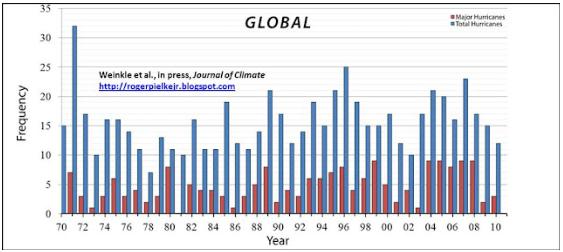
. Some interesting trends (or lack thereof) at
Roger Pielke Jr's blog:
"
Weinkle et al. 2012 is now online at the Journal of Climate. I provided a summary of the paper a few months ago when it was accepted, including these factoids:
- Over 1970 to 2010 the globe averaged about 15 TC landfalls per year
- Of those 15, about 5 are intense (Category 3, 4 or 5)
- 1971 had the most global landfalls with 32, far exceeding the second place, 25 in 1996
- 1978 had the fewest with 7
- 2011 tied for second place for the fewest global landfalls with 10 (and 3 were intense, tying 1973, 1981 and 2002)"
Compound Found In Red Wine Could Fight Obesity. Pass the red wine please (cork optional - a fine box wine will work). Details from
gizmag.com: "
Researchers from Purdue University in Indiana are testing a compound found in red wine that has the ability to block the processes of fat cell development. The research into the compound known as piceatannol may lead towards finding a simple method to combat obesity. Piceatannol results from the conversion of resveratrol – a compound found in red wine, grapes and peanuts that is also thought to combat cancer, heart disease and neurodegenerative diseases. When resveratrol is converted into the piceatannol compound, which naturally occurs after consumption, the compound has the ability to delay fat cell growth."
Flood Of Video Streaming Options Could Confound TV Watchers. Here's an interesting read from
USA Today: "
Streaming video is about to hit its tipping point. Competing online video services have become so successful that about one-third of Americans have streamed a movie or TV show on Netflix, Hulu, Vudu, Crackle or another Net-based video service, according to Nielsen. Americans will watch 3.4 billion movies online this year, more than doubling 2011's total and exceeding DVD and Blu-ray consumption for the first time, estimates researcher IHS Screen Digest. "We are looking at the beginning of the end of the age of movies" on discs, says IHS senior principal analyst Dan Cryan." Image above: USA Today.
Kirin Topping Drinks With "Soft Serve" Frozen Beer Foam. And why the heck not? I have a theme going here. No, I don't have a "problem", do I? I just found this fascinating - more from
gizmag.com: "
We've seen plenty of innovative ways to keep beer cold in recent months, with everything from a refrigerator with a built-in blast chiller to a can that cools itself at the push of a button. But these have all involved cooling the beer's container, leaving the liquid inside to warm up at the same rate as any other beverage. That's why Japanese beer maker Kirin has gone a different route, and developed a method for cooling the beer directly and, more importantly, keeping it chilled for much longer. The company's new Ichiban Shibori Frozen Draft stays at a low temperature thanks to a specially-developed machine that dispenses a topping of frozen beer foam like soft serve ice cream."
 The Internet Is Ruining Your Brain
The Internet Is Ruining Your Brain. No kidding. And here I thought it was the Kirin frozen beer foam or too much obesity-fighting red wine. I'm so confused.
Mashable.com (and a great infographic) sets me straight: "
Admit it: As you’re reading this, you have tunnel vision — that feeling that the world is closing in on you after surfing the Internet for eight straight hours. Web dead head (yes, I made that up) is a growing concern for today’s connected generation, which collectively spends 35 billion hours on the Internet every month. But we’re not just talking one online shopping experience at a time. Often, we have four tabs open, cycling between emails and shopping, tweeting and word processing. Such multi-tasking actually raises stress levels and lowers creative thinking overall, according to the research compiled by ForensicPsychology.net."
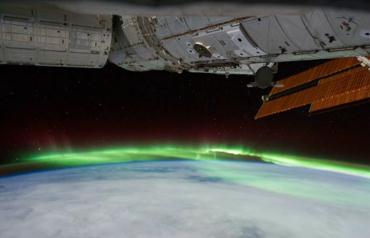
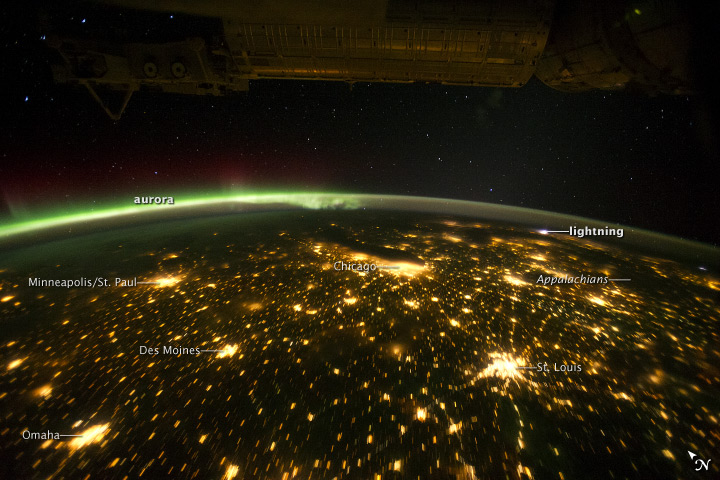 Aurora From Space.
Aurora From Space. Oh, to be able to get this view outside your family room window. Image courtesy of NASA's International Space Station (ISS).

Rain "Opportunity"
Here's a stumper: can frozen flowers catch fire? I hope not. I've spent part of my morning performing Last Rites on my tulips, which have seen better days.
Sustained temperatures below 26F can kill peaches, plums and pears. Colder than 24F? The apple crop begins to die. If you got through last night unscathed - congratulations. Long range guidance is hinting at a light frost around April 25, but no more hard freezes are brewing through the end of April.
Until further notice you will not hear me babble about a "threat of rain" or a "risk of showers", even on a weekend. Minnesota's drought is getting worse; a nagging fire risk until we see a few meaningful storms. If we're lucky a northbound warm front may spark a half inch of rain Friday and Saturday. But to be clear: most Minnesota towns need anywhere from 3-9 inches of rain just to get back up to "normal".
Suggestion: borrow a friend's boat until further notice. There are going to be some seriously dinged-up propellers on our lakes. The impact on agriculture may be considerable.
"Tornadoes or drought Paul - what's it going to be this summer?" Lovely choice. My gut is telling me drought. I hope I'm wrong. It's happened before.
Climate Stories...
Now This Is Interesting: A Climate Prediction From 1981. The story at
The Atlantic: "
It is very much worth checking out an item on Real Climate, from two Dutch scientists. They have found a paper by James Hansen and others from 1981, before climate change was even an occasion for political disagreement. Hansen is now famous in the world of climate studies, and infamous to the world of the right wing, but back then he was a 40-year-old researcher who came up with a projection of how rising CO2 levels might affect global temperatures. Science lives for the "falsifiable hypothesis" -- a claim that can be tested against the evidence -- and that is what the paper by Hansen and his colleagues offered up. Three decades later, his worst-case projections were matched against what has happened since then. You should read their full findings, but this gives you the idea."
3 Signs Of Hope And One Omen On Climate Change. Here's an excerpt from a story at
Huffington Post: "
With magazines like Scientific American publishing articles titled: "Global Warming Close to Becoming Irreversible," and 15,000-plus temperature records set this spring in the U.S., it's no wonder the CFO of the business I work for said to me yesterday: "I have this crippling anxiety about climate change... what are our children going to have to deal with?" At Keystone, in Colorado, ski season is still going on but a nearby fire meant the lodge was being used as an evacuation center a few weeks ago. Meanwhile, the Washington Post expressed bafflement about U.S. inaction in the face of obvious climate threats highlighted by the Organization for Economic Cooperation and Development."
Water Wise: Prepare For Climate Change. Here's an Op-Ed from
The Salt Lake Tribune: "
The Natural Resources Defense Council charges that Utah is behind the curve in planning for drought due to climate change. State water officials say that’s baloney. We believe the truth lies somewhere in between. Utah has done some good planning and is pushing water conservation. But it could do more, and it would help if extremists in the Legislature would quit passing resolutions that climate change is a scientific hoax. It’s not. The NRDC is a private environmental organization. It has written a report ranking the states by how they are planning to deal with climate change. Utah falls in the worst category." Photo credit: NASA.
Climate Change Could Be Tough On Seniors' Health. Yes, being a near-senior, I perked up when I saw this article. Now I can blame my aches and pains on climate change. Perfect!
MSN.com has more details: "
MONDAY, April 9 (HealthDay News) -- Even small swings in temperatures could put elderly people with chronic illnesses such as diabetes, heart failure and lung disease at greater risk of death throughout the coming summer, a new study indicates. Researchers from the Harvard School of Public Health in Boston found temperature fluctuations related to climate change could claim thousands of lives every year. Experts predict climate change could increase variations in summer temperatures, particularly in the mid-Atlantic states and in parts of France, Spain and Italy. In these more volatile regions, this could pose a serious public health risk, the study authors claimed."
How Climate Change Affects Plant Growth. Some interesting new details from
cattlenetwork.com: "
Global warming may initially make the grass greener, but not for long, according to new research conducted at Northern Arizona University. The study, published this week in Nature Climate Change, shows that plants may thrive in the early stages of a warming environment but begin to deteriorate quickly. “We were really surprised by the pattern, where the initial boost in growth just went away,” said Zhuoting Wu, NAU doctoral graduate in biology. “As the ecosystems adjust, the responses changed.” Researchers subjected four grassland ecosystems to simulated climate change during the decade-long study. Plants grew more the first year in the global warming treatment, but this effect progressively diminished over the next nine years, and finally disappeared."
It's Time For Interfaith Moral Action On Climate Change. Here's an Op-Ed from Bill McKibbon at
Huffington Post: "
There are lots of types of people who have been taking action on climate change over the last several years: environmentalists (of course), students and young people, community-based groups, labor activists, indigenous peoples, Appalachian and Gulf Coast residents, ranchers and more. Among them, importantly, have been people from the many different denominations that make up the broad religious community in the United States. It was personally inspiring to me when several dozen people of faith took action last August, getting arrested at the White House protesting the Keystone XL pipeline. And it is inspiring that some of those people, as well as many more, have joined together to organize five days of faith-based activities calling for action on climate change in Washington, D.C. April 22 to 26. The Interfaith Moral Action on Climate Change is playing a key role in organizing and connecting these activities."
Will Climate Change Affect The Incidence Of Diseases And Medical Conditions? A question answered by
The New York Times: "
There is increasing evidence of lives being lost both directly, to causes like heart and respiratory ills, and indirectly, as the animal vectors of disease spread to newly warmer areas, according to a review article in the journal Nature in 2005. While no specific weather event can be directly linked to warming caused by greenhouse gases, the authors cited a two-week heat spell in Europe in the summer of 2003 that led to 22,000 to 45,000 heat-related deaths. Diseases like malaria (spread by mosquitoes), plague (by fleas) and Lyme disease (by ticks) are predicted to surge as the carriers enjoy climate-related conquests of territory." Photo credit: USDA.
Evidence In Science And Religion, Part 2. An interesting read/Op Edfrom
The New York Times: "
In the post previous to this one, I revisited the question of the place of evidence in the discourses and practices of science and religion. I was prompted by a discussion on the the show “Up w/ Chris Hayes” (MSNBC, March 25) in which Steven Pinker and Richard Dawkins stated with great force and confidence that a key difference between science and religion is that the conclusions of the former are based on evidence that has emerged in the course of rigorous rational inquiry publicly conducted, while the conclusions of the latter are based on dogma, faith, unexamined authority, subjectivity and mere trust. In response, Hayes observed that as laypersons, with respect to most areas of science we must take on trust what practitioners tell us. I took Hayes’s point further than he might be willing to take it, and suggested that because trust is common to both enterprises, the distinction between them, at least as it is asserted by Pinker and Dawkins, cannot be maintained."
Photo credit above: "
Meridian United Methodist Church Rev. John McCorkell delivers the sunrise message during the 92 annual Sutter Buttes Sunrise Easter Service Sunday, April 8, 2012 in Sutter, Calif. An estimated 750 people attended the hilltop worship service. (AP Photo/Appeal-Democrat, Chris Kaufman)."





